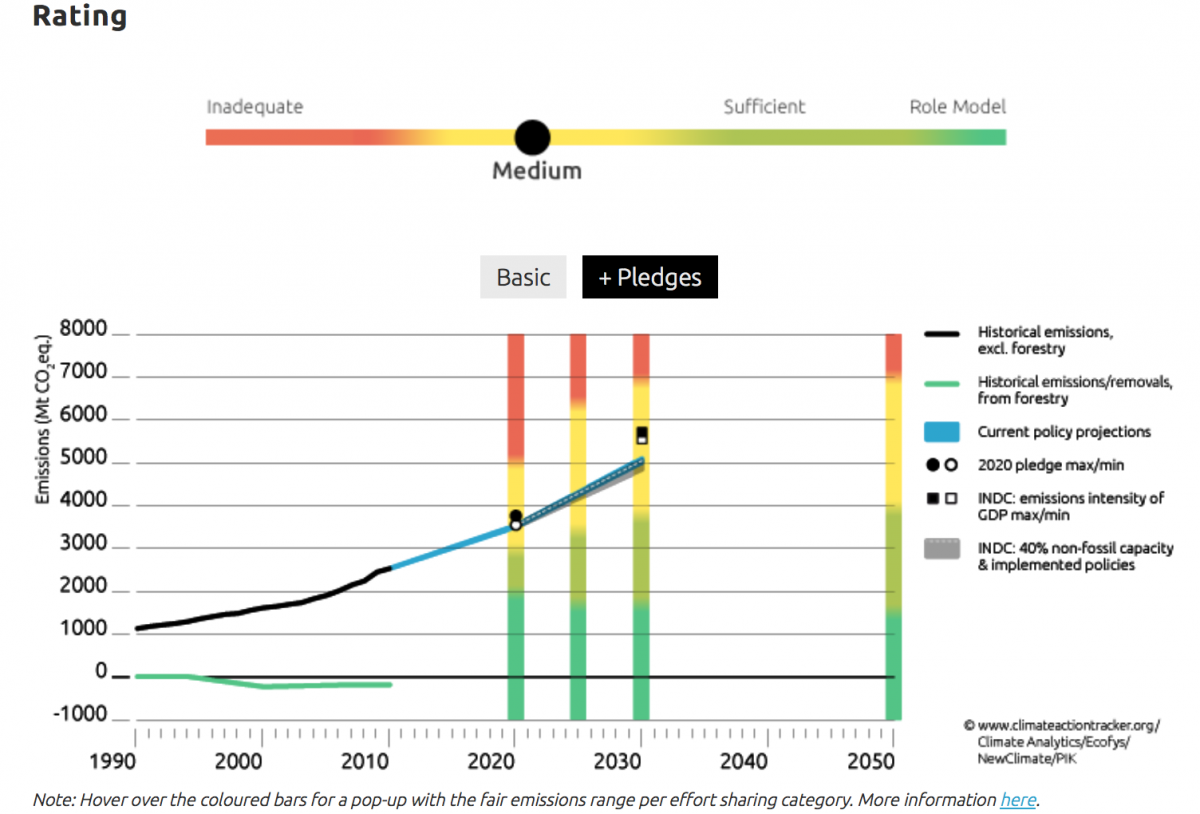New analysis from the Climate Action Tracker group has found that India, now the world’s third largest emitter of carbon, is likely to easily outstrip the pledge it made ahead of a key United Nations summit in December this year.
As a fast-growing source of emissions, India’s progress on cutting carbon will be increasingly vital in coming decades if the world is to achieve its aim of limiting the rise in average global temperatures to two degrees or less.
The sub-continent’s commitments ahead of Paris were lodged last week, and it will aim for 40 per cent non-fossil fuel energy by 2030. It will also work to reduce the emissions intensity of its economy — the amount of carbon produced per unit of GDP — by 33 per cent by the same year, based on 2005 levels.
The country had been tipped to announce a more ambitious plan, including a goal of 350,000 gigawatt hours of renewable energy, but in the end it maintained an earlier commitment to installing 175,000 gigawatt hours by 2022.
Still, Professor Kornelis Blok from the Ecofys group that forms part of Climate Action Tracker, maintains that “India has been unnecessarily cautious in setting its emissions intensity target”.
“Given the [extensive]supporting mechanisms and policies in place, it is expected to be feasible that India will meet its ambitious renewable energy targets,” Blok said.
The Climate Action Tracker (CAT) analysis rated India’s level of ambition as “medium”, but it said that the vast array of policies India is already implementing would likely mean that by 2030 36 per cent of India’s power generation capacity will be clean, even in the absence of further renewable energy targets post-2022.
That’s just four per cent shy of its new target, and the analysis also suggested that with the policies it has in place India will reduce its emissions intensity by 41.5 per cent by 2030, which is nearly ten per cent above what it has committed to.
Jemma Green, an advisor to the Carbon Tracker group and Research Fellow at Curtin University, said she “saw the draft wording of [India’s Paris target] and it was much stronger than what they’ve ended up with”.
“[There were] lots more firm commitments in the final draft that were taken out of the final [published]version,” Green said. “But you can see the direction of their travel [and]I think they’re really committed to climate action.”
A key sign of that commitment is the extensive suite of policies India is already implementing to encourage renewable energy. They include a requirement that any new coal-fired power stations must be accompanied by renewables projects of at least 10 per cent their capacity, new taxes on coal, and tax breaks for clean energy projects.
One of the sticking points for the developing economy though, as it grapples with alleviating entrenched poverty and extending ‘electricity to all’, is that it needs finance from developed countries and the private sector to bring on new renewables capacity.

The Australasia Director of Finance Studies at the Institute of Energy Economics and Financial Analysis, a US-based clean energy think tank, Tim Buckley said there is already a flood of private capital getting behind the growth market in renewables in India.
“I am very much of that camp that it’s going to be market that dictates the transition as inevitable,” Buckley said.
“When we talk about India needing access to hundreds of billions of dollars of capital, that’s not asking for a hand out — what they’re asking for is debt and equity from global organisations to fund it.
“Even as they’re waiting on the politicians to come to the party, it’s actually going to be the corporations that will drive this process and we’re seeing the corporates facilitate the energy transformation as we speak,” Buckley said.
To give one key example, Indian energy giant Adani has committed to invest $16 billion across eight solar projects, which is ironically the same investment it has proposed in a massive and controversial new Australian coal mine in the Galilee Basin.
Of course, India’s coal consumption is still increasing steeply. But while the CAT analysis argued India’s “continued growth in coal-fired power generation would lead to a greater lock-in of carbon-intensive power infrastructure than appears necessary,” changing markets may mean long-term forecasts around growth in total fossil fuel usage may never materialise.
As a step in that direction, the Indian Coal Minister has signalled an imminent end to imported coal, which Green said sends an important signal to global markets and investors given that India is the second largest consumer of the polluting commodity.
Much of India’s domestic coal market is state-owned, and so can be changed rapidly as market conditions vary and the price of renewables falls, but the CAT analysis suggests the overall growth rate of renewables will outstrip that of coal. It estimates that under current policies India’s growth rate in wind and solar will be around 11 per cent per year, whereas coal’s will be lower at 7 per cent.
If it can secure adequate supply of uranium, India is also keen to drastically expand the market share of nuclear energy.
“There are two targets — one for 2022, and the second for 2030 — and the 2022 target is actually very aggressive,” Buckley said.
“I’m confident they’re going to achieve that target and in doing that build the capacity they need to significantly upgrade the level of intent of the 2030 target.”
The Chief Executive Officer of climate advocacy group 350.org’s Australian arm, Blair Palese said that “in many ways India’s commitments put Australia’s to shame”.
“They’ve set out a strong renewable energy transition and a clear willingness not only to be at the table in Paris but to be a real leader at the table,” she said.
“For a developing country with so many challenges to stand so strong on climate change and show that to address the issue can mean real economic opportunity is something Australia could, sadly, learn from.”
Donate To New Matilda
New Matilda is a small, independent media outlet. We survive through reader contributions, and never losing a lawsuit. If you got something from this article, giving something back helps us to continue speaking truth to power. Every little bit counts.




